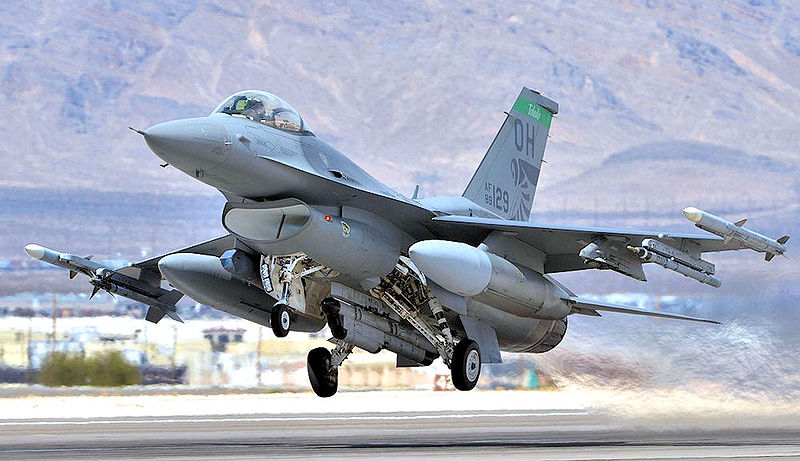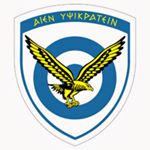F-16C/D Block 40/42.

An armed F-16C Block 42G in landing. Source/Credits:commons.wikimedia.org
Entering service in 1988, the Block 40/42 is the improved all-day/all-weather strike variant equipped with LANTIRN pod; also unofficially designated the F-16CG/DG, the night capability gave rise to the name "Night Falcons". This block features strengthened and lengthened undercarriage for LANTIRN pods, an improved radar, and a GPS receiver. From 2002, the Block 40/42 increased the weapon range available to the aircraft including JDAM, AGM-154 Joint Standoff Weapon (JSOW), Wind-Corrected Munitions Dispenser (WCMD) and the (Enhanced) EGBU-27 Paveway "bunker-buster". Also incorporated in this block was the addition of cockpit lighting systems compatible with Aviator's Night Vision Imaging System (ANVIS) equipment. The USAF's Time Compliance Technical Order (TCTO) that added the night vision (NVIS)-compatible systems was completed in 2004. A total of 615 Block 40/42 aircraft were delivered to 5 countries. source/credits:https://en.wikipedia.org/wiki/General_Dynamics_F-16_Fighting_Falcon_variants

Aerial view of jet aircraft, carrying cylindrical fuel tanks and ordnance, overflying desert. A U.S. Air Force F-16 Fighting Falcon Block 40 aircraft after receiving fuel from a KC-135 Stratotanker aircraft during a mission over Iraq on 10 June 2008. This F-16 is assigned to the 34th EFS Balad Air Base, Iraq and is deployed from the 388th Fighter Wing at Hill Air Force Base, Utah. (U.S. Air Force photo by Master Sgt. Andy Dunaway/Released) Source/Credits:Master Sgt. Andy Dunaway
History
History
Structure & Avionics
The configured engine bay has options for either the General Electric F110-GE-100 (Block 40) or the Pratt & Whitney F100-PW-220 (block 42), although the two engines are not routinely interchangeable. The airframe was provided with greater structural strength, which raised the 9G capability from 26,900 pounds to 28,500 pounds. Maximum take-off weight was increased to 42,300lbs (19,187kg).
The undercarriage legs were made longer in order to provide more adequate clearance for the two underfuselage LANTIRN pods, and were beefed up to handle the increased weight. The aircraft also has bulged landing gear doors to accommodate the larger wheels and tires, and the landing lights were moved to the nose gear doors.
Modifications & Upgrades
The Martin-Marietta LANTIRN (Low-Altitude Navigation and Targeting Infra-Red for Night) system consists of two separate pods, each mounted underneath the air intake. The AAQ-13 navigation pod is on the left, the AAQ-14 targeting pod is on the right. The navigation pod has terrain-following radar and FLIR, whereas the targeting pod has FLIR and a laser designator. The LANTIRN must interface with the flight controls, since the pod flies the airplane while in terrain-following mode.
The F-16C/D Block 40/42 aircraft were initially fitted with only the navigation pod, since the targeting pod was delayed by technical difficulties. Provisions for the Texas Instruments (now part of Raytheon) AGM-88 HARM II were added in 1989. The precision weapons incorporated by the Block 40/42 include the GBU-10, GBU-12, GBU-24 Paveway family of laser-guided bombs as well as the GBU-15 glide bomb. Some foreign versions of the aircraft can carry the AIM-7 Sparrow missile.
Sure Strike
In 1995, 38 F-16C/D Block 40 aircraft of USAFE's 31st Fighter Wing based at Aviano AB, Italy, were equipped with Sure Strike. This package consists of Night Vision Goggles (NVG) and an Improved Data Modem (IDM), giving the aircraft quick reaction capability for CAS missions over Bosnia.
The IDM (now standard on the Block 50/52 and MLU aircraft) allows the aircraft to receive latitude, longitude and elevation of a target direct from a FAC (Forward Air Controller) on the ground. The system then inputs the data into the weapon system computer and displays it as a waypoint on the HUD.
Made up entirely from off-the shelf components, it took just 13 weeks to field Sure Strike. The success of the program led to the USAF ordering that Sure Strike software is to be included in conjunction with a rapid release software update recently requested by USAF to improve the weapon-to-aircraft interface of the AIM-120 Advanced Medium Range Air-to-Air Missile (AMRAAM). This action ensures that Sure Strike capability will be included in the major software upgrade (Block 40 tape five) for the close air support update planned in June 1998.
Gold Strike
In July 1997, Lockheed Martin was awarded a contract to upgrade the Sure Strike system under a project called Gold Strike. Gold Strike basically adds two-way imagery transmission to Sure Strike, enabling the pilot to receive and transmit video images in the cockpit.
Software changes will be made within the core avionics computers to display the video images on the F-16s Multi-Function Display (MFD) and to transmit images from the LANTIRN targeting pod. Upon successful completion of the demonstration, the USAF has the option to incorporate this capability in the Sure Strike-modified Block 40 F-16s at Aviano Air Base in Italy.
Production
Production of the block 40/42 totals 615 airframes. Manufacturing started in 1989 as a successor of the block 30/32 airframe. It ended in the late nineties with a follow-on order from Egypt. Block 40 aircraft were delivered to the USAF, Turkey, Bahrain, Israël and Egypt. Block 42 aircraft were only delivered to the USAF.
Specifications
Engine: One Pratt & Whitney F100-PW-220 turbofan, rated at 14,590 lb.s.t. dry and 23,770 lb.s.t. with afterburning or one General Electric F110-GE-100 turbofan, rated at 17,155 lb.s.t. dry and 28,984 lb.s.t. with afterburning.
Performance: Maximum short-endurance speed: Mach 2.02 (1333 mph) at 40,000 feet. Maximum sustained speed Mach 1.89 (1247 mph) at 40,000 feet. Tactical radius (hi-lo-hi interdiction on internal fuel with six 500-lb bombs) 360 miles. Maximum ferry range 2450 miles with maximum external fuel.
Dimensions: wingspan 31 feet 0 inches, length 49 feet 4 inches, height 16 feet 8 1/2 inches, wing area 300 square feet.
Weights: 18,238 pounds empty, 26,463 pounds normal loaded (air-to-air mission), 42,300 pounds maximum takeoff.
